By Iris Farrou
21 Mar, 2021
Menstruation
Best gyns in Buffalo, Best OB practices in Buffalo, Best OBGYN Groups in Buffalo, Buffalo OB-GYN, Buffalo OBGYN, Chouchani MD, Normal menstruation cycle, WNY OB-GYN, WNY OBGYN, women's health tips
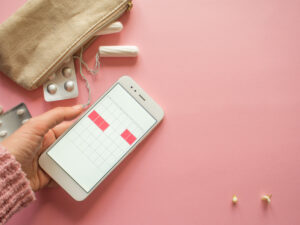
When your doctor asks when your last cycle was, there’s no need to jog down memory lane, as you can simply open an app on your smartphone. Cycle tracking apps are helpful with everything from monitoring mood and fertility to alerting us of reproductive system illnesses. If you search for “period tracker” in your app store, the 50+ choices can seem overwhelming.
Here’s a list of favorite cycle tracking apps:
Clue Period & Cycle Tracker
Clue has been accredited by the Obstetrics & Gynecology Journal (ACOG) as the Top Free Period Tracking App, the Best Fertility App by Healthline, and App of the Day Worldwide by the Apple App Store. Clue is female-led and doctor recommended. It lets you log cramps, mood fluctuations, sex drive, sleep schedule, food cravings, and over 30 other categories. The more consistently you log your cycle, the more accurately the app predicts your body’s rhythm. It also alerts you when certain changes or fluctuations may indicate a health issue. Clue’s custom push notifications notify you with shocking accuracy to events like the beginning of your cycle, ovulation, and PMS.
Life – Period Tracker Calendar
This sleek app integrates with HealthKit, allowing you to synchronize your custom data with your phone’s Health App. You can track nutrition, fitness, moods, weight, medication, and more in the most customizable app available. Life also integrates irregular cycle support and allows you to keep separate entries for each symptom so as to easily share it with your physician at a later time. Additionally, you can prevent false alerts about irregularities that may not concern you by personalizing your cycle length. Life is backed and used by licensed physicians, gynecologists and has over 50,000 glowing reviews.
Glow Period and Fertility Tracker
Glow is modern care for your fertility, plus tracking for over 40 different biological symptoms. “Glow Scoops,” a resource section built into the app, has an expansive library of informational articles on topics like egg freezing and menstrual health. You can also export custom PDF reports of your ovulation or fertility health charts to simplify the pregnancy process, and join support communities for issues like IVF, IUI, and natural pregnancy. Glow has a team-based mentality, including generating personal data that your medical care professionals can use to better know your body, and diagnose health issues early and efficiently.
Eve Tracker App
With a recently redesigned Cycle Chart, Eve is a savvy period tracker and sex app for women looking to take control of their health and sex lives. Eve is a spicier type of tracking app that includes the typical interactive tracking data, and also has daily sex quizzes so you can own your cycle and feel good in bed. The interactive staircase helps you see your menstrual history in a new light and has a community of women that discuss sex and health issues. Eve is also compatible with the Health app and has an interactive calendar view for every step of your cycle.
More
By Iris Farrou
06 Jan, 2021
Menstruation
Best gyns in Buffalo, Best OB practices in Buffalo, Best OBGYN Groups in Buffalo, Buffalo OB-GYN, Buffalo OBGYN, Chouchani MD, missed period, Normal menstruation cycle, WNY OB-GYN, WNY OBGYN

Irregular or missed periods happen for many reasons besides pregnancy. While most women have a period every 28 days, a healthy cycle can range from 21 to 35 days. So, it’s helpful to keep in mind that normal is relative to each person. There are many other reasons that can cause irregular or missed periods.
Most people have some amount of stress in their daily lives—let’s face it, in a pandemic, who isn’t experiencing some stress? Even with tactics to manage stress (working out, meditation, therapy, healthy eating, etc.), stress can cause physical symptoms, including altering your period. Significant stress can disrupt your hormonal balance, which may lead to delayed, irregular, heavy, or even missed periods.
- Weight loss/Too much exercise
While losing weight is usually good, losing weight too quickly can also affect your hormones. The loss of a hormone in fatty tissue called leptin can lead to the loss of other hormones, including estrogen, which may cause your period to be irregular.
- Low body weight/Eating disorders
Women with eating disorders, such as anorexia nervosa or bulimia, may also experience missed or irregular periods. In fact, women may stop ovulating if they weigh 10% below the normal range for their height. Gaining weight usually triggers the body to return to normal ovulation, but eating disorders are serious. Seeking medical help is imperative.
- Polycystic ovary syndrome (PCOS)
Affecting about 5% to 10% of women, PCOS is a medical condition caused by an imbalance of reproductive hormones. With an imbalance of estrogen, your period could come more or less frequently than normal.
Going on or off birth control may affect your cycle right away or even months later. Birth control pills contain hormones, estrogen and progestin, which stop your ovaries from releasing eggs. In fact, low-estrogen birth control pills, IUDs, and shots can even trigger a light or non-existent period. It may take up to three months for a period to return to normal after a women goes off birth control.
In addition to causing weight gain or weight loss, thyroid disorders can affect hormones, leading to irregular or missed periods. The thyroid regulates the body’s metabolism, which can alter hormone levels.
If you experience an irregular period with other symptoms (fever, severe pain, unusually heavy bleeding, etc.), you should contact your doctor right away. Otherwise, keeping a log of your period can help your doctor diagnose the issue.
More
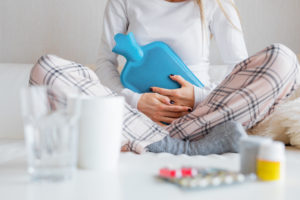
What causes cramps?
Many women experience menstrual cramps, either a few days before they get their period or in the first few days—when the cramps are likely to be more painful. Cramps are caused by contractions in the uterus and cause pain in the lower belly area. These contractions help the period blood flow out. Cramps are usually more prevalent when people first start menstruating, but this does not mean that they completely disappear as women age; they usually become less painful, but they may also become more painful.
Over-the-counter Medication
One of the quickest ways to deal with menstrual cramps is to take an over the counter medication. Though in cases of extreme pain, doctors will prescribe pain medication to their patients, anti-inflammatory over the counter medicine such as ibuprofen, aspirin, and naproxen sodium are most commonly used. While you may be inclined to start taking the medicine once the pains begin, anti-inflammatory medications actually work best if you take them before you start hurting too bad or the day before your period begins. It is recommended to keep taking the medicine for as long as the pain continues, but there are home remedies that you may find ease the pains as well.
Heat
Heat helps muscles relax and this is no different when it comes to menstrual pains. Applying a heating pad, a hot water bottle, or a heat wrap to your abdomen may work as well as medication to relieve cramps. If you do not own these items, you may use a hot towel or take a hot bath/shower to help relax your muscles.
Exercise
In a similar manner, exercising helps the flow of menstrual blood and its quicker, easier discharge. Additionally, exercising helps release endorphins, brain chemicals that promote general well-being. You can enjoy any form of exercise that works for you during your period, but if you find regular exercise difficult you can consider gentler forms of it, such as walking or yoga.
Diet and Hydration
Though they don’t work as quickly as medicine, heat, or exercise, proper diet and hydration can help your body deal with menstrual pains. Bloating is probably one of the most uncomfortable parts of menstrual pains and drinking more water than usual during your period can help you feel better; since you are also losing fluids, try to drink at least 6 to 8 glasses of water per day.
You may be craving salty and/or sweet kinds of food during your period, but these do not actually help with the menstrual pain. Instead, you may want to try consuming more anti-inflammatory foods such as cherries, blueberries, tomatoes, bell pepper, and squash. Cinnamon, ginger, dill, and turmeric consumption also helps with the pains.
Takeaway
Whatever route you choose to take to help you lessen the pains during menstruation, remember that you should always follow the medicinal recommendations and consult your doctor if you are experiencing an abnormal amount of pain, or an extreme amount of blood flow as they may be indicative of a serious health condition.
More
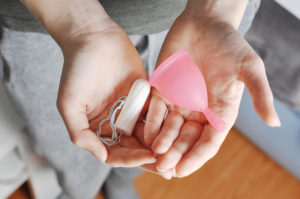
A lesser known alternative to sanitary pads and tampons, the menstrual cup is another device menstruating individuals can utilize. Though it can be found in all major pharmacies and the oldest ads for it date back to the 1930s, the menstrual cup has only recently begun gaining popularity with women.
Shaped like a bell, menstrual cups are usually made of silicone, rubber, or latex. A menstrual cup is inserted into the vagina during your period to collect menstrual blood and fluids in its receptacle. In contrast to tampons and pads, which are absorbent, you have to empty out the reusable cup when it is full.
Advantages
Menstrual cups are relatively easy to clean, as they need to be rinsed off with warm water between uses during menstruation and washed off with warm water and soap between periods. They should be stored in breathable containers, such as a cloth bag.
A cup usually becomes full in 4-6 hours, but that may depend on the flow of one’s period—menstrual cups can be used for up to 12 hours before they need to be emptied out, which makes them more durable and less expensive than other methods. This is in addition to their reduced landfill, since the life length of one cup is around 10 years.
Menstrual cups stay in place and gather the fluids with suction, which makes the possibility of leakage and unpleasant odors significantly less than if using other methods. Because they are non-absorbent, the danger of menstrual cups negatively affecting the pH of the vaginal area or creating an environment friendly to bacteria is actually less in comparison with absorbent, cotton-based methods.
Disadvantages
Though all in all a more financially and environmentally smart solution than tampons and pads, menstrual cups do come with some challenges.
The most significant concerns raised have to do with the insertion and placement of the cup: it needs to be inserted into the vagina so that it’s at a 45 degree angle, thus giving it the correct shape to collect the blood. This requires some practice, especially since the cup needs to be turned once in the vagina to suction on the vaginal walls correctly and to not become displaced. Some women may not be comfortable placing the cup, nor do they receive clear instructions on how to do so effectively. Incorrect placement of the cup can make it uncomfortable to wear or result in leakages and more mess than necessary. Other possible fit problems may be presented depending on each person’s anatomy; each body is different, and some may find a cup simply does not fit them.
Another disadvantage of the cup concerns its removal, as it can be tricky: the cup should not be pulled, but its bottom should be pinched to make it thinner, cease the suction, and safely remove it from the vagina, while emptying out its contents in the toilet bowl.
Takeaway
As is the case with every available method, menstrual cups will be a better solution for some people than they will be for others. Overall, this device does not seem to be presenting as many health concerns as absorbent methods, but it does have a higher “ick” factor that may make some uncomfortable, or even cause embarrassment.
More
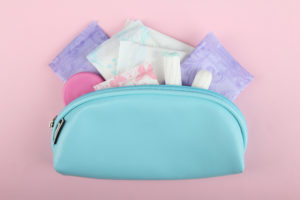 Most women who have handled a box of tampons have come across the words “toxic shock syndrome” (TSS) without spending much time contemplating tampon safety. This rare, but potentially life-threatening, condition is caused by bacterial infections, mainly the Staphylococcus Aureus or the Streptococcus bacteria. TSS is mostly associated with the use of tampons as it is thought that the bacteria thrive in the presence of a super-absorbent tampon. Possible symptoms include high fever, rash on the palms and soles, low blood pressure, vomiting or diarrhea, muscle aches, headaches, disorientation, and redness of the mouth, throat and eyes.
Most women who have handled a box of tampons have come across the words “toxic shock syndrome” (TSS) without spending much time contemplating tampon safety. This rare, but potentially life-threatening, condition is caused by bacterial infections, mainly the Staphylococcus Aureus or the Streptococcus bacteria. TSS is mostly associated with the use of tampons as it is thought that the bacteria thrive in the presence of a super-absorbent tampon. Possible symptoms include high fever, rash on the palms and soles, low blood pressure, vomiting or diarrhea, muscle aches, headaches, disorientation, and redness of the mouth, throat and eyes.
Although TSS can affect anyone, most cases caused by the Staphylococcus bacteria occur in women of menstruating age, followed by cases occurring in older women, children, and men. As far as tampon use is concerned, use of super-absorbent tampons, as well as use of tampons when there is low blood flow, may be increasing the risk of TSS.
To reduce the risks of TSS, focus on these tampon safety tips:
- Change tampons every few hours
- Avoid tampons with applicators, as they increase the danger of scraping the vaginal walls
- Be gentle when inserting and/or removing tampons
- Avoid using tampons overnight or when the flow is light
- Maintain personal hygiene during your period and thoroughly wash your hands before and after handling tampons
- Use tampon immediately after unwrapping and avoid handling more than necessary
- Do not use tampons if you are not on your period
In addition to TSS, tampons can also expire. Some companies may provide an expiry date on the tampon boxes, but that may not always represent the life cycle of the tampons. You may hear that the shelf life of a tampon is about five years, but this comes with certain requirements.
To be safe when using tampons, consider the following:
- Tampons are sanitary, but not sterile
- If there’s no expiration date, write the purchase date on the box
- Always keep tampons in their original packaging and away from excessive moisture, as this reduces the risk of contamination
- The bathroom is NOT the best place to store your tampons: find a cabinet that’s cool and dry
- Don’t let tampons loose in your purse—to avoid ripping the packaging store tampons in a small bag or pouch
- Remember that debris, dust, dirt, and/or mold are not always visible; if the packaging has been ripped or if you have stored tampons in less-than-ideal conditions, it is best to not use them
- Do not use a tampon if there’s noticeable discoloration, mold patches and/or odor
More
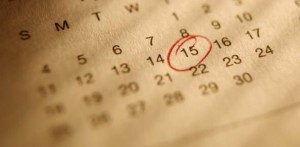 There’s really no such thing as a “normal” period, only because every woman’s period, or menstrual cycle, is unique. But girls and women of all ages have questions, because your cycle will also change over the course of your lifetime. Here are some frequently asked questions from the perspective of different age groups.
There’s really no such thing as a “normal” period, only because every woman’s period, or menstrual cycle, is unique. But girls and women of all ages have questions, because your cycle will also change over the course of your lifetime. Here are some frequently asked questions from the perspective of different age groups.
Teenagers
Almost all teenage girls wonder “When will I get my period?” If they haven’t already, that is! Usually, girls get their periods at around age 11 or 12, but it can happen at any age from 8 to 16. It may happen around the same time that your mom first got hers. If you haven’t gotten your period within three years of when your breasts started to grow, talk to your parent or guardian, your doctor or another adult you trust.
Four other common questions that teenagers ask?
- What exactly is “a period”? Once you’ve hit puberty, your uterus will build up a lining of blood and tissue to prepare for the possibility of being pregnant. That lining would be needed if your egg was fertilized by a sperm cell, as a place for the egg to attach and begin growing into a baby. When the egg doesn’t get fertilized, that blood and tissue comes out.
- What will it look like? Your period flow can be light, heavy, or somewhere in between. It can be light red or dark red and may change from day to day.
- How long will it be? Periods usually last between three and five days, but it’s normal to have periods that are either shorter or longer. It is also normal if your periods are not the same number of days each month, especially in the first years.
- When does it happen? In general, a menstrual cycle takes place over about one month, around 23 to 35 days. But every female’s cycle is different. Try to keep track of when you get it, so you can see if a pattern forms.
Women In Their Thirties and Forties
As you move past your peak fertility years, even if you’ve always had regular periods, you may experience longer, irregular cycles up to 45 days. You may see signs of approaching menopause, like hot flashes and mood changes.
If you’re not approaching menopause, other causes of irregular periods may include stress dramatic weight loss, or sudden weight gain. All of these conditions can affect your body’s hormone levels and may cause changes in the length of your cycle. Medications such as antidepressants can also cause cycle changes. Talk to your doctor if you see any consistent changes in your cycle.
Any more questions? Need a doctor or other professional you can talk to? Call or contact Chouchani, Sayegh and Bagnarello M.D. anytime. You’ll love our caring and knowledgeable doctors and staff.
More






